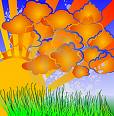CBT self help course step 3
Continued from Step 2
Printable PDF: Step 3
Use the Self Help mp3 downloads to strengthen therapy or as a stand-alone technique
See also: The Decider Skills for Self Help online course
The documents linked from the bottom of each page are intended to be an integral part of this course, and should not be omitted - the worksheet documents are included in the downloadable Steps linked above.
DOING DIFFERENTLY
Changing what we normally do can greatly affect they way we feel and think. 
When you look at your 'Vicious Cycle' form where you wrote down your thoughts, feelings (emotions and physical sensations) and behaviours, notice particularly what you wrote for 'behaviours'. Very often we react automatically, without considering our actions or the consequences of them.
- What helped you cope and get through it?
- What didn’t I do or what did I avoid doing?
- What automatic reactions did I have?
- What would other people have seen me doing?
- What were the consequences of what I did? What happened later because of it? Did it affect the way I felt later?
Now ask yourself, what could I have done differently?
- What would someone else have done in that situation? (it might help to think about particular people that you know, and what they might have done differently)
- Have there been times in the past when I would have done something else?
- If I had paused, and taken a breath, what would I have done?
Write down several options that you might have done differently if it had occurred to you, then ask yourself:
- If I had tried that, how would the situation have been different?
- How would it have affected what I felt?
- How would it have affected what I thought?
- Would it have been more helpful or effective for me, another person or for the situation?
- What would the consequences have been of doing something differently?
Learn to face your fears by using graded exposure to overcome avoidance.
FACE Fear and Avoidance - video
Dealing With Distressing Situations:
Practice and learn to STOPP and take a breath before considering what action to take. Just simply pausing and taking a breath when feeling distressed can help us to see the situation more clearly, and help us decide what action to take.
and learn to STOPP and take a breath before considering what action to take. Just simply pausing and taking a breath when feeling distressed can help us to see the situation more clearly, and help us decide what action to take.
Choose to do what works! 
When considering your options, ask yourself:
- Will it be effective and appropriate?
- Is it in proportion to the event?
- Is it in keeping with my values and principles?
- What will be the consequences of my action?
- What is best for me and most helpful for this situation?
Some suggestions for coping with crises and distressing emotions:
- STOPP
- Pause, take a breath
- Do something different (to what you normally do)
- Mindfulness
- Focus your attention fully on another activity - NOW
- Relaxation techniques - try lots and find one that works for you
- Put on some music - sing and dance along, or just listen attentively - use music that is likely to help you feel your desired emotion (no sad songs if you're depressed)
- Meditation or Prayer

- Help others
- Be with others - contact a friend, visit family
- Talk to someone
- Grounding techniques - look around you, what do you see, hear, smell, sense? Hold a comforting object.
- Get a balance of energising and draining activities
- Physical exercise - walk, swim, go to the gym, cycle
- Engage in a hobby or other interest - if you don't have one, find one! What have you enjoyed in the past? What have you sometimes thought
 about doing but not got around to?
about doing but not got around to? - Write down your thoughts and feelings - get them out of your head
- Just take one step at a time - don't plan too far ahead
- Pamper yourself - do something you really enjoy, or do something relaxing
- Positive self-talk - encourage yourself, tell yourself: I can do this, I am strong and capable - find an affirmation that works for you (even if you don't believe it at first!). Write it down and memorise it for when you need it.
- Do something creative - make a box of items that remind you to use the
 techniques that help, or put photos on paper, or write and decorate a list
techniques that help, or put photos on paper, or write and decorate a list - Learn to Notice the Positives
- Use Safe Place Imagery
- Tell yourself: "This will pass, it's only temporary". "I've got through this before, I can do it now". When we're going through a tunnel and become fearful of being trapped, there's no point in stopping - we just have to carry on in order to reach the end of the tunnel. That light is there, and waiting!

Activity & Physical Exercise
- Makes us feel better
- Makes us feel less tired
- Motivates us to do more
- Improves our ability to think more clearly
- Uses up the adrenaline resources created by anxiety and anger
- Increases motivation
- Makes us generally more healthy
When we're depressed, we can feel particularly tired and lack any motivation to do anything. Just increasing our activity and exercise levels can make an enormous impact on our mood as it stimulates the body to produce natural anti-depressants.
Use ACE to help you Achieve, Connect with Others and Enjoy, every day.
ACE Activity - video
Do More Energising And Less Draining Activity
The Battery - LIFT vs DROP Activities
The Battery: LIFT vs DROP activities - video
Use either or both of these sheets to record what you do and how it affects your mood.
Use this sheet for helping you to set yourself GOALS
Use the Treatment Plan to help you plan what you need to do more of or start, or what you can do less of or stop:
- Treatment Plan or webpage
- MMT Self-Help- more information
- Communication Styles: Passive - Assertive - Aggressive or webpage
- Problem Solving Worksheet or webpage
- Vicious Cycle & Alternatives

Breathing And Relaxation helps to combat the body's adrenaline fight & flightresponse that occurs in Anxiety and Anger, and the agitation and ruminating thoughts of Depression. Try different relaxation techniques - some will work better for you than others.
Information:
- Mindful Breathing
- Imagery & Visualisation
- Colour Breathing
- Meditation
- Relaxation Exercises
- Listening To Music
- Relaxation & Imagery Mp3 Downloads
More information:
- Defusing Exercises
- Relaxation & Imagery MP3 Downloads
- ACE
- The Battery - LIFT vs DROP Activities
- SHARP Specs: Notice the Positives
Purposeful Activity - video
Use the Self Help mp3 downloads to strengthen therapy or as a stand-alone technique
See also: The Decider Skills for Self Help online course


